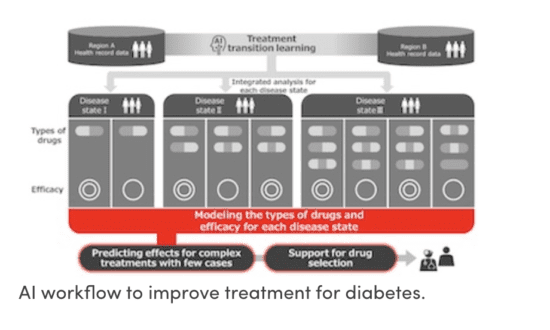In the last post, we discussed the collaboration between University of Utah Health, the Regenstrief Institute and Hitachi for the development of a new artificial intelligence approach that could improve treatment for patients with Type 2 diabetes mellitus. Pooling data from different institutions enabled an AI-based approach that groups patients with similar disease states and then analyzes treatment patterns and clinical outcomes. The model then matches specific patients to the disease state groups and predicts a range of potential outcomes depending on different treatment options.
Researchers assessed how well this method worked for predicting successful outcomes for drug regimens administered to patients with diabetes in Utah and Indiana. Their findings showed that the algorithm was able to support medication selection for more than 83% of patients, even when two or more medications were used together.
Part of the thinking behind this effort was that while 10% of adults throughout the world have been diagnosed with Type 2 diabetes, a smaller percentage requires multiple medications to control blood glucose levels and avoid serious complications, such as the loss of vision and kidney disease. For this group of patients, physicians may have limited clinical decision-making experience or evidence-based guidance for choosing drug combinations. It’s hoped that this new AI-enabled clinical approach can help patients who require complex treatment by checking the efficacy of various drug combinations.
Still on the subject of diabetes, Twin Health’s Whole Body Digital Twin platform collects thousands of data points each day from wearable sensors, then combines those readings with the results of blood tests and self-reported questionnaires to build a computer model of each patient. The AI continuously updates and analyzes the model to spot problem areas in a patient’s individual metabolism and suggest potential changes and improvements for their nutrition, activity, sleep and breathing, all with the ultimate goal of reversing diabetes symptoms. In a clinical trial, they showed impressive results using this approach to reverse diabetes.
The company’s clinical trial analyzed 199 patients who’d been diagnosed with diabetes for an average of almost four years and who began the study with an average A1C of 9%. After six months, researchers found that with the sustained use of the digital twin technology, almost 95% saw A1C levels drop below 6.5%. They reported an average drop of 3.3 points compared to improvements of just 0.39 in the trial’s control group, which received the current standard of care for Type 2 diabetes. The digital twin group was able to achieve that drop without relying on any medications besides metformin. In addition, all nine of the patients who’d been using insulin were able to stop injections before the 90-day point.






